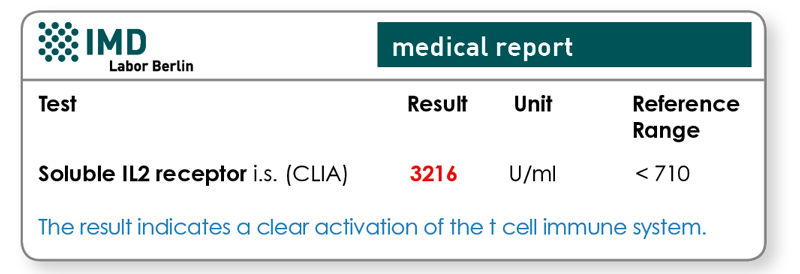Serum-soluble IL-2 receptor
T lymphocytes play a key role in the immune system. They are responsible for maintaining cellular immunity against persistent intracellular pathogens (viruses, bacteria, parasites) amongst others.
Interleukin-2 (IL-2, T-cell growth factor) is the most important cytokine involved in T cell activation. It stimu-lates proliferation of T lymphocytes and enables them to exert their effector functions, e.g., activating additional T cells and monocytes/macrophages, activating cytotoxic T cells and aiding in antibody synthesis. However, quantitative measurement of IL-2 in the serum has not been diagnostically relevant to date.
Soluble IL-2 receptor can now be used to quantify lym-phocytic activation. The binding of interleukin 2 to the IL-2 receptor on the lymphocyte surface communicates the actual activation stimulation to the T lymphocytes. IL-2 activated lymphocytes increase the number of membrane-bound IL-2 receptors and also release a soluble form (soluble IL-2 receptor = sIL-2R) into the bloodstream. The function of the sIL-2R is to bind excess IL-2 and to subsequently release it (depot action). The sIL-2R can be measured at a low level in the serum of healthy volunteers and increases significantly in a range of diseases with T cell activation (see indications). Unlike global activation markers of inflammation such as CRP or ESR, sIL-2R specifically and rapidly indicates that T lymphocytes are activated in the patient and is thus very well suited for diagnosing and monitoring these immune-related diseases.
Indications for measuring serum soluble IL-2 receptor
- Diagnosing and monitoring sarcoidosis (best course pa- rameter, better than ACE)
- Rheumatoid arthritis and other connective tissue dis- eases (due to its high turnover rate, it is particularly suitable for assessing the success of treatment with ste- roids and other anti-inflammatory preparations)
- Other active T-cell-mediated immune diseases such as reactive arthritis, chronic inflammatory bowel disease or hepatitis
- Suspected lymphoproliferative diseases (usually drastic increases with B and T lymphomas)
- Suspected rejection reactions with allotransplant recip- ients (primarily kidneys, heart)
Monitoring immune activation after immunostimulant therapy is not an indication for measuring soluble IL2 receptor. The level of the sIL2 receptor in the serum does not correlate with the function of the T lymphocytes because the sIL2 receptor is released by both cytotoxic and regulatory (suppressor) CD4 and CD8 lymphocytes. The lymphocyte transformation test (LTT Immune Function) is suitable to determine the T cell function.

Fig. 1 Sample report
Material
2 ml whole blood
Sample receipt within 24 hrs has to be ensured. The sample should be stored and transported at room temperature. Within the Berlin city area, we offer a courier service (+49 (0)30 7701- 250). For collections beyond Berlin, please contact our complimentary courier service (+49 (0)30 77001- 450).
Invoicing
Please obtain the costs for the test from the pdf-document.
We would be glad to send you detailed information about the serum cytokine diagnostics (TNFα, IL-6), the underlying medical and scientific principles and therapeutic consequences.
